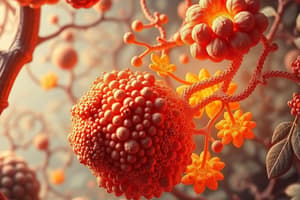Podcast
Questions and Answers
In Gluconeogenesis, which of the following is the primary reason why glucose is needed during fasting conditions?
In Gluconeogenesis, which of the following is the primary reason why glucose is needed during fasting conditions?
- To synthesize glycogen for storage in the liver.
- To maintain blood sugar levels and supply glucose to tissues that exclusively depend on it. (correct)
- To provide a quick burst of energy for muscle contraction.
- To aid in the digestion of fats and proteins.
Why is it more efficient for the body to store energy as fats rather than glycogen?
Why is it more efficient for the body to store energy as fats rather than glycogen?
- Fats can be converted into glucose more quickly than glycogen.
- Glycogen requires more energy to synthesize than fats.
- Fats provide more kilocalories per gram and do not absorb water like glycogen. (correct)
- Glycogen is only stored in the liver and muscles, whereas fats can be stored throughout the body.
In which primary organs does gluconeogenesis occur?
In which primary organs does gluconeogenesis occur?
- Stomach and intestines
- Brain and muscles
- Liver and kidneys (correct)
- Pancreas and spleen
Which of the following is NOT a precursor for gluconeogenesis?
Which of the following is NOT a precursor for gluconeogenesis?
Why must oxaloacetate be converted to malate before it can leave the mitochondria during gluconeogenesis?
Why must oxaloacetate be converted to malate before it can leave the mitochondria during gluconeogenesis?
What is the role of biotin (B7) in the conversion of pyruvate to oxaloacetate?
What is the role of biotin (B7) in the conversion of pyruvate to oxaloacetate?
Which enzyme catalyzes the conversion of oxaloacetate to phosphoenolpyruvate?
Which enzyme catalyzes the conversion of oxaloacetate to phosphoenolpyruvate?
What is the effect of AMP on fructose-1,6-bisphosphatase during gluconeogenesis?
What is the effect of AMP on fructose-1,6-bisphosphatase during gluconeogenesis?
What is the function of glucose-6-phosphate translocase in gluconeogenesis?
What is the function of glucose-6-phosphate translocase in gluconeogenesis?
Which transporter is responsible for moving free glucose from the cytosol into the bloodstream in liver?
Which transporter is responsible for moving free glucose from the cytosol into the bloodstream in liver?
How does fructose-2,6-bisphosphate regulate gluconeogenesis and glycolysis?
How does fructose-2,6-bisphosphate regulate gluconeogenesis and glycolysis?
Why does the body prioritize the synthesis of glucose during fasting, even though it requires energy?
Why does the body prioritize the synthesis of glucose during fasting, even though it requires energy?
What is the role of Acetyl CoA in the regulation of pyruvate carboxylase?
What is the role of Acetyl CoA in the regulation of pyruvate carboxylase?
Why is glucose-6-phosphatase located in the endoplasmic reticulum (ER)?
Why is glucose-6-phosphatase located in the endoplasmic reticulum (ER)?
How does citrate regulate glycolysis and gluconeogenesis?
How does citrate regulate glycolysis and gluconeogenesis?
What is the main role of glucokinase regulatory protein (GKRP) in regulating glucokinase activity?
What is the main role of glucokinase regulatory protein (GKRP) in regulating glucokinase activity?
In the context of enzyme regulation, what is 'feed-forward activation'?
In the context of enzyme regulation, what is 'feed-forward activation'?
Which of the following accurately describes the roles of GLUT2 and GLUT7 in gluconeogenesis and glucose transport?
Which of the following accurately describes the roles of GLUT2 and GLUT7 in gluconeogenesis and glucose transport?
Which of the following statements regarding the comparison between hexokinase and glucokinase is most accurate?
Which of the following statements regarding the comparison between hexokinase and glucokinase is most accurate?
Which condition would most likely result in an increased contribution of the kidney to gluconeogenesis?
Which condition would most likely result in an increased contribution of the kidney to gluconeogenesis?
Flashcards
Gluconeogenesis
Gluconeogenesis
The synthesis of glucose from non-carbohydrate precursors.
Why do we need glucose under fasting conditions?
Why do we need glucose under fasting conditions?
To maintain blood sugar levels and supply glucose to tissues that exclusively depend on it for energy (e.g., brain cells).
Glycogen storage in the liver.
Glycogen storage in the liver.
Liver stores the most glycogen (around 75g), but this is only enough to supply the brain for about 16 hours.
Where does Gluconeogenesis occur?
Where does Gluconeogenesis occur?
Signup and view all the flashcards
Gluconeogenesis Precursors
Gluconeogenesis Precursors
Signup and view all the flashcards
Key Gluconeogenesis Enzymes
Key Gluconeogenesis Enzymes
Signup and view all the flashcards
Oxaloacetate transport from mitochondria
Oxaloacetate transport from mitochondria
Signup and view all the flashcards
Fructose 1,6-bisphosphatase
Fructose 1,6-bisphosphatase
Signup and view all the flashcards
Glucose 6-phosphatase
Glucose 6-phosphatase
Signup and view all the flashcards
Glucose Transporters in Gluconeogenesis
Glucose Transporters in Gluconeogenesis
Signup and view all the flashcards
Energy Required for Gluconeogenesis
Energy Required for Gluconeogenesis
Signup and view all the flashcards
Glucokinase vs. Hexokinase
Glucokinase vs. Hexokinase
Signup and view all the flashcards
Phosphofructokinase-1 Regulation
Phosphofructokinase-1 Regulation
Signup and view all the flashcards
Fructose 2,6-bisphosphate Role
Fructose 2,6-bisphosphate Role
Signup and view all the flashcards
Citrate's role in Glycolysis and Gluconeogenesis
Citrate's role in Glycolysis and Gluconeogenesis
Signup and view all the flashcards
Fructose 1,6-bisphosphate feed forward
Fructose 1,6-bisphosphate feed forward
Signup and view all the flashcards
Role of ATP in Glycolysis
Role of ATP in Glycolysis
Signup and view all the flashcards
Role of ADP in Gluconeogenesis
Role of ADP in Gluconeogenesis
Signup and view all the flashcards
Role of Acetyl CoA in Gluconeogenesis
Role of Acetyl CoA in Gluconeogenesis
Signup and view all the flashcards
Study Notes
- Gluconeogenesis is the opposite of glycolysis, building glucose instead of breaking it down.
- The body follows different metabolic pathways depending on whether it's well-fed or fasting.
- Glycolysis occurs when well-fed (high blood glucose), while gluconeogenesis is important when fasting or low on food.
- Gluconeogenesis synthesizes glucose from non-carbohydrate precursors when sugar is unavailable.
Reasons for needing glucose in fasting conditions
- Maintain blood sugar levels because glucose acts as a solute in the blood which contributes to osmotic pressure.
- Low glucose affects osmotic pressure, causing problems with water movement and blood pressure instability affecting bodily functions.
- To supply tissues exclusively dependent on glucose for energy, such as brain cells, limbs, and adrenal medulla.
- The brain consumes around 120 grams of sugar daily, with glycogen stores not being sufficient for even 24 hours.
Glycogen Storage
- All cells store glycogen, with the liver storing the most (around 75g), lasting about 16 hours for the brain.
- Muscles can store up to 400g of glycogen, but it's only for muscle cell use.
- 20 grams of glycogen is found in the extracellular matrix as glucose aminoglycan needed for ECM processes which cannot be used for energy.
Glycogen Limitations
- Glycogen levels are limited because sugars are polar which means they absorb water.
- Increased glycogen leads to water absorption, creating a gel-like structure which is not ideal.
- Fats don't absorb water, allowing for bigger storage without water retention with more energy preserved per gram.
Energy Comparison of Fats vs Carbohydrates
- Fats provide 9 Kilocalories per gram, while carbohydrates provide 4 Kilocalories per gram.
- A 70 kg person with 15 kg of fats has 135,000 kilocalories of energy stored which is calculated by 9 x 15000 = 135000 kilocalorie
- Storing the same energy as carbohydrates would require 33.750 kg of carbohydrates because 135000/4 = 33.750 Kg with a huge water absorption as well.
- Energy is mostly stored as fats due to the large difference in energy density and water absorption.
Gluconeogenesis Location and Precursors
- Gluconeogenesis primarily occurs in the liver and kidneys, with 90% in the liver and 10% in the kidneys.
- During extended fasting (weeks), the kidneys can contribute up to 40%.
- Multiple precursors can be used; lactate, produced in muscles from anaerobic respiration and RBCs.
- Amino acids are used as precursors (alanine being the most common) which when the amino group is removed, turns into pyruvate
- Amino acids that can be used to make glucose are called glucogenic amino acids.
- Glycerol, from fatty tissues, is another precursor where triacylglycerol is broken down yielding fatty acids (for energy) and glycerol (for gluconeogenesis).
- Precursors are transported to the liver and kidney, then glucose is released into the bloodstream.
Gluconeogenesis Process
- Precursors enter gluconeogenesis at different stages where alanine turns into pyruvate.
- Lactate can be turned into pyruvate by lactate dehydrogenase.
- Some amino acids (aspartate) degrade into oxaloacetate (stage 2), while glycerol enters at stage 3.
- Gluconeogenesis is the reverse pathway of glycolysis, starting with two pyruvate and ending with one glucose.
- All reversible steps use the same enzymes in reverse.
- Irreversible steps: phosphorylation of glucose, de-phosphorylation of fructose 6 phosphate and fructose 1,6 – biphosphate, and pyruvate kinase are undergone by different enzymes
- The conversion of pyruvate to phosphoenolpyruvate involves two steps catalyzed by two enzymes.
- Pyruvate is first turned into oxaloacetate, then oxaloacetate into phosphoenolpyruvate.
- Gluconeogenesis consists of 11 steps which differ from glycolysis.
- Pyruvate is obtained from external sources (amino acids, lactate)
Pyruvate Carboxylation
- Pyruvate might be inside the mitochondria (glycolysis occurs in the cytosol).
- Pyruvate is taken outside via carboxylation adding carboxyl to pyruvate which turns it into oxaloacetate (4C).
- Carboxylation needs ATP, catalyzed by the coenzyme biotin (B7).
- Oxaloacetate lacks a transporter to leave the mitochondria.
- Oxaloacetate is reduced into malate via oxidation of NADH to NAD+, and malate leaves through a transporter and is oxidized back into oxaloacetate.
- This step is supported by a pyruvate carboxylase enzyme.
Oxaloacetate to Phosphoenolpyruvate
- Oxaloacetate is turned into phosphoenolpyruvate.
- Phosphoenolpyruvate has 3 carbons, while oxaloacetate has 4 so one carbon is removed as CO2.
- A phosphate group from GTP is added, catalyzed by PEP carboxykinase and then proceeds through reversible steps from glycolysis. phosphoenolpyruvate → 2-phosphoglycerate (enolase is involved) 3-phosphoglycerate (mutase) → 1,3- bisphosphoglycerate(kinase) → Glyceraldehyde-3-phosphate (dehdrogenase).
- The second pyruvate undergoes the same reaction until Glyceraldehyde-3-phosphate.
- Each Glyceraldehyde-3-phosphate is converted into dihydroxyacetone phosphate by isomerase and aldose connects them, creating fructose 1,6-bisphosphate.
- Fructose 1,6-bisphosphate has a phosphate removed via fructose 1,6-bisphosphatase, turning it into fructose 6-phosphate where AMP inhibits the enzyme.
- Fructose 2,6-bisphosphate (regulatory molecule) turns on glycolysis and turns off Gluconeogenesis, acting as a "Switch Molecule" present in opposing reactions.
- Fructose 6-phosphate isomerizes into glucose 6-phosphate, then glucose 6-phosphatase transforms it into glucose.
- Glucose 6-phosphatase is in the ER, so glucose 6-phosphate is transported inside via glucose 6-phosphate translocase.
- Once inside the ER and the phosphate is removed, glucose is transferred outside via GLUT7 (on the ER membrane), and then GLUT2 (in the liver) transports it to the bloodstream.
Energy Consumption
- Total of 6 energy molecules are used to create one glucose.
- Turning pyruvate into oxaloacetate requires 2 ATP.
- Oxaloacetate into phosphoenolpyruvate requires 2 GTP.
- 3-phosphoglycerate into 1,3 phosphoglycerate uses 2 ATP.
- The body prioritizes glucose synthesis even requiring energy while fasting.
- The phosphate groups stripped in the reaction cannot be re-used in synthesizing ATP due to their insufficient energy.
Regulation of Glycolysis and Gluconeogenesis
- Regulation occurs in the 3 irreversible steps, using different enzymes for each pathway.
Glycolysis Regulation - First Irreversible Step
- First irreversible step which involves glucokinase and hexokinase (catalyze the same reaction with slight differences).
- Glucokinase functions when there's high glucose (well-fed state)
- Hexokinase functions continuously at a slow Vmax, regardless of glucose concentration.
- Km of hexokinase is low, while glucokinase is high.
Glucokinase Regulation
- Sequestration: At low sugar levels, Glucokinase is "exiled" and inactive in the nucleus, bonded to glucokinase regulatory protein (GKRP).
- When glucose increases, the bond splits, and glucokinase activates.
- When fructose 6-phosphate increases during glycolysis, it signifies increased sugar levels.
- Fructose 6-phosphate activates sequestration (not the enzyme), exiling Glucokinase to bind to GKRP again.
Glycolysis Regulation - Phosphofructokinase 1
- AMP activates phosphofructokinase 1 when needing energy, while under gluconeogenesis, it inhibits it.
- ATP facilitates gluconeogenesis, but is not a direct allosteric regulator.
- Fructose 2-6-bisphosphate activates glycolysis and inhibits Gluconeogenesis.
- Citrate inhibits glycolysis and activates Gluconeogenesis. High citrate indicates the Krebs Cycle and no breaking down of glucose is needed.
- H+ protons inhibit glycolysis indicating Krebs and electron transport chain are ongoing as well.
- These are all allosteric regulators for the reversible transformation of fructose 6-phosphate to fructose 1-6,bisphosphate vice versa.
- Phosphofructokinase 1 regulators: AMP and fructose 2,6-bisphosphate. Its normal curve is sigmoidal. Substrate fructose 2,6-bisphosphate greatly speeds up activation.
Glycolysis Regulation - Pyruvate Kinase
- In glycolysis, fructose 1,6 bisphosphate (from the previous irreversible step) is used.
- Feed forward regulation: A product of a previous step activates a forward step where fructose 1,6-bisphosphate (F-1,6BP) from phosphofructokinase 1 activates the last step of glycolysis.
- ATP inhibits the forward reaction of glycolysis. High levels of ATP indicates a high amount of energy.
- Alanine inhibits glycolysis and is the source of pyruvate for Gluconeogenesis.
- ADP inhibits ADP because it shows a low energy state.
- Acetyl CoA activates the carboxylation of Pyruvate into oxaloacetate while fasting.
- Fasting leads to degradation of fatty acids, producing abundant Acetyl CoA.
- This also indicates that degradation of fatty acids is ongoing because we are fasting.
Studying That Suits You
Use AI to generate personalized quizzes and flashcards to suit your learning preferences.




